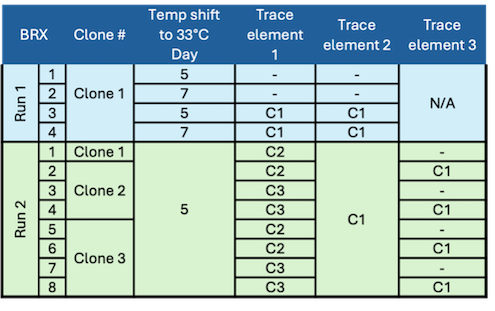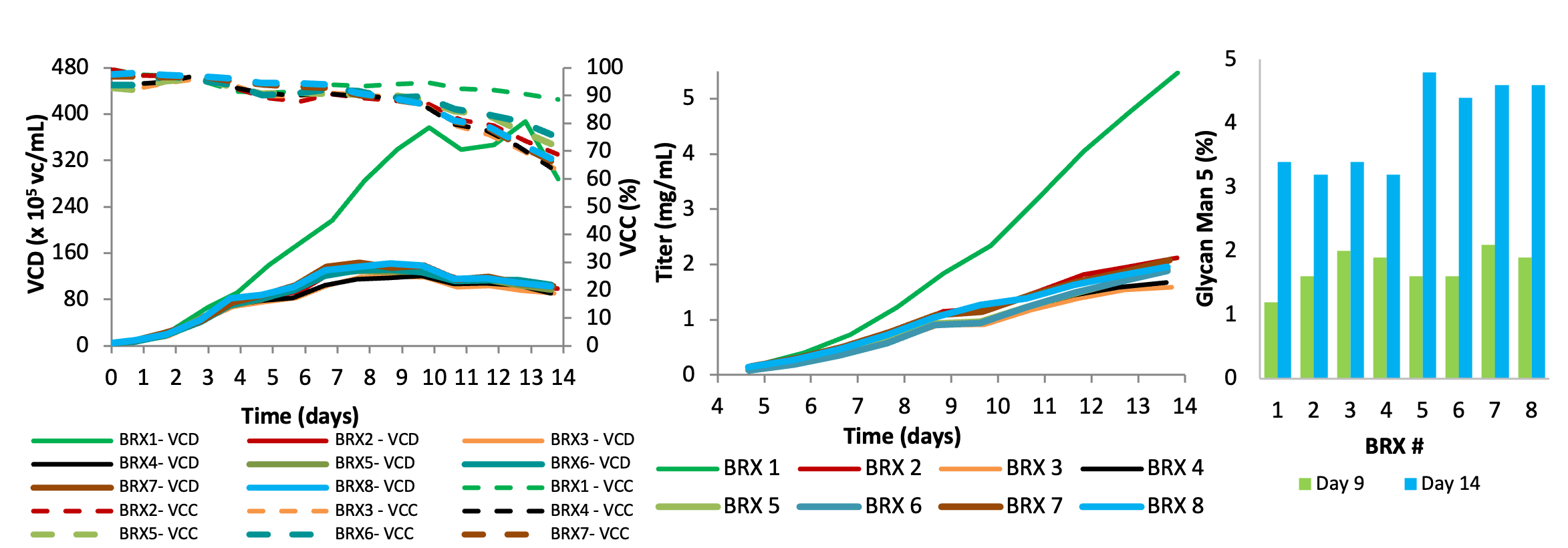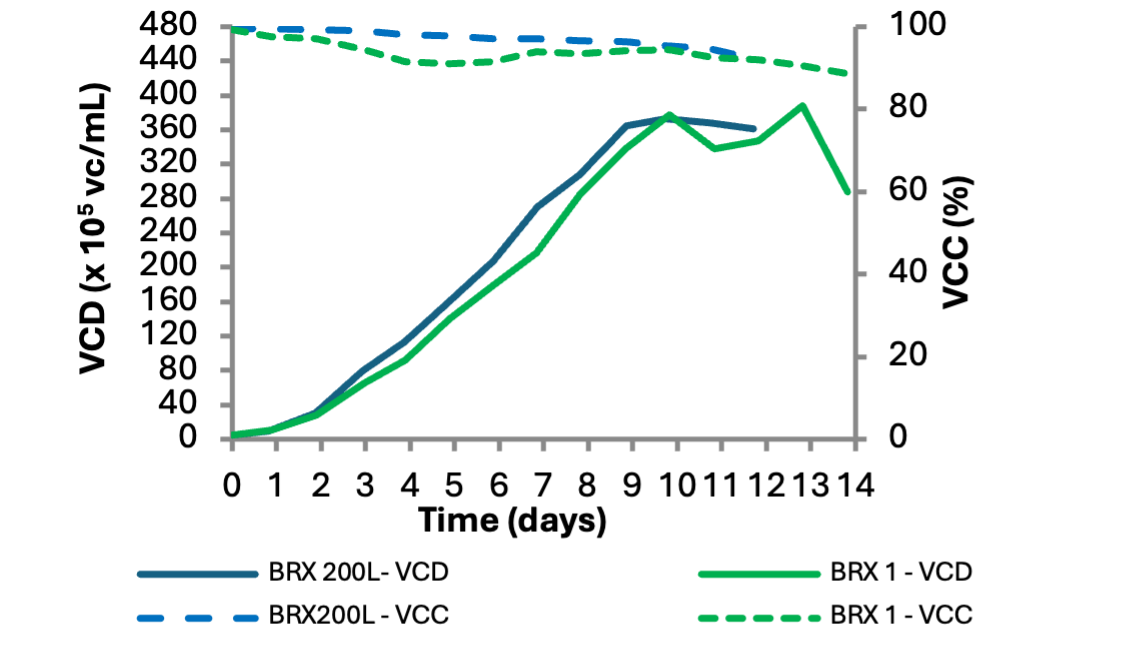One challenge for manufacturing of a biosimilar is to define the process design space in an efficient way to obtain high similarity with the reference product. Here a GBI case study is described comprising a Design of Experiments (DoE) for the process development at 5-L scale bioreactor (BRX) for production of a biosimilar using three clones. The main objective was to reduce the relative abundance of mannose-5 (Man-5) glycoforms in the product and increase the yield. The process parameters were defined and the developed process was successfully scaled up to 200-L BRX.
Introduction
The basis of the development process for a biosimilar is the establishment of a high degree of structural similarity with its reference product. As part of development and optimization activities, GBI explores the DoE studies that help develop process knowledge by revealing relationships, including multivariate interactions, between variable inputs and resulting performance parameters. Many variables can affect strain performance within a bioprocess, making the experimental design space extremely large for bioprocess development and often impossible to test empirically in a full factorial manner. GBI proposes a custom 5-L BRX scale design that can significantly reduce the number of experiments to solve the problem, either by identifying important effects or trying to optimize one or more responses. Furthermore, the 5-L scale DoE allows sufficient material to be generated for the development of the downstream process (DSP). Since it is well characterized, it allows precise control of the critical process parameters (CPPs) and is a good precedent for scale-up. In the proposed case study, two DoE studies were performed at 5-L BRX scale.
Objectives
Identify the impact of the most important parameters on the performance of the strain by analyzing productivity and critical quality attributes (CQA) of the biosimilar produced.
Select the best of three research cell bank (RCB) clones and bioprocess conditions.
Methods
The DoE Run 1 was performed in 4 BRXs with Clone 1 to evaluate the effect of trace elements on yield and Man-5 content. The DoE Run 2 performed to test the performance of Clones 2 and 3 in 8 BRXs was designed based on the results obtained in Run 1.
 Results and Discussion
Results and Discussion
On Run 1, the maximum viable cell density (VCD) was reached on day 10 (BRX1), day 8 (BRX2), and day 11 (BRX3 and BRX4). BRX4 showed the highest VCD during the run (Figure 1).
The cell viability (VCC) for all the BRXs on run 1 was maintained between 96 and 99% until day 4. On day 5, the VCC started decreasing until harvest on day 14, showing a range of 91 to 97% (Figure 1).

Figure 1:Viable cell density and % viability; titer and Man-5 percentage in glycan profile for the 4x5L BRX (clone 1)
BRX3 and BRX4 from run 1 showed the higher titer (around 4 mg/mL) on the day of harvest; and low Man-5. Man-5 content is a key CQA for the target protein, and it was a target requirement for biosimilarity as part of the glycosylation profile. BRX3 and BRX4 were supplemented with trace elements 1 and 2 at one concentration C1.
 Figure 2:VCD and % VCC; titer and Man-5 percentage in glycan profile for the 8 x 5-L BRX run 2 (clone 1, 2, and 3)
Figure 2:VCD and % VCC; titer and Man-5 percentage in glycan profile for the 8 x 5-L BRX run 2 (clone 1, 2, and 3)
On run 2, clone 1 (BRX 1) showed a greater growth rate reaching higher VCD in comparison to Clones 2 and 3. Clone 1 (BRX 1) reached a maximum VCD of 38.7 x106 vc/mL on day 13. In this Run 2 it was observed that VCC for Clones 2 and 3 markedly decreased from day 9 until the end, it is possible to infer that it was due to the increase in the concentration of trace element 1 and trace element 3 (Figure 2).
On harvest Day, BRX1 clone 1 showed the highest titer of 5.5 mg/mL, and the highest specific productivity (qP) of 18.61 pg/cells.day.
In addition, the results suggest a decrease in the Man-5 containing species of 45% for cell culture day 9 and 13% for cell culture day 14 for clone 1 with the increase of trace element 1 from C2 to C3.
The BRX1 5-L scale was scaled to a 200-L BRX; day 12 was selected as harvest day. The results were comparable to the process development results as expected. VCD and VCC profiles obtained in the two runs were equivalent (Figure 3). Titer was 3.8 mg/mL and qP 15.81 pg/cells.day.
 Figure 3: VCD and % VCC for 200-L BRX compared to those from BRX 1 (Run 2-Clone 1)
Figure 3: VCD and % VCC for 200-L BRX compared to those from BRX 1 (Run 2-Clone 1)
Summary and Conclusions
DoE approach was applied by GBI to successfully investigate the ability of trace element additive ranges and temperature shifts to reduce and control mannosylation in a bioreactor system for biosimilar production and to increase productivity.
The three clones produced a biosimilar of equivalent quality when compared to the reference material as determined by SEC-HPLC, cIEF, and N-glycan.
Higher performance was observed for clone 1 in the BRX supplemented with trace element 1 at C2 concentration and trace element 2 with C1 concentration.
GBI successfully scaled up the process developed at 5-L to 200-L BRX scale. Results indicated production of high-quality biosimilar product equivalent to the 5-L BRX scale.
The GBI DoE approach of 12 BRXs, based on in-house expertise, allows for a reduction of up to 1/8 on time and cost compared with a traditional full factorial DoE.

